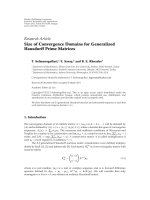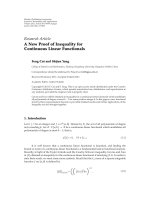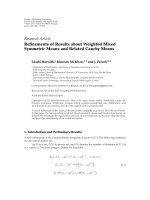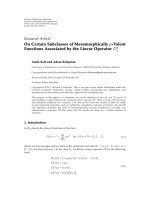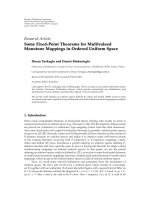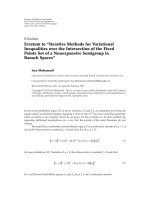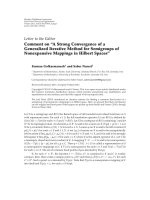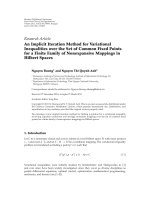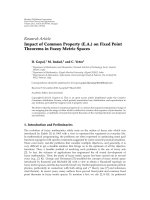Hindawi Publishing Corporation Journal of Inequalities and Applications Volume 2011, Article ID pptx
Bạn đang xem bản rút gọn của tài liệu. Xem và tải ngay bản đầy đủ của tài liệu tại đây (556.58 KB, 19 trang )
Hindawi Publishing Corporation
Journal of Inequalities and Applications
Volume 2011, Article ID 350973, 19 pages
doi:10.1155/2011/350973
Research Article
Refinements of Results about Weighted Mixed
Symmetric Means and Related Cauchy Means
L
´
aszl
´
o Horv
´
ath,
1
Khuram Ali Khan,
2, 3
and J. Pe
ˇ
cari
´
c
2, 4
1
Department of Mathematics, University of Pannonia, University Street 10,
8200 Veszpr
´
em, Hungary
2
Abdus Salam School of Mathematical Sciences, GC University, 68-B, New Muslim Town,
Lahore 54600, Pakistan
3
Department of Mathematics, University of Sargodha, Sargodha 40100, Pakistan
4
Faculty of Textile Technology, University of Zagreb, 10000 Zagreb, Croatia
Correspondence should be addressed to Khuram Ali Khan,
Received 26 November 2010; Accepted 23 February 2011
Academic Editor: Michel Chipot
Copyright q 2011 L
´
aszl
´
o Horv
´
ath et al. This is an open access article distributed under the
Creative Commons Attribution License, which permits unrestricted use, distribution, and
reproduction in any medium, provided the original work is properly cited.
A recent refinement of the classical discrete Jensen inequality is given by Horv
´
ath and Pe
ˇ
cari
´
c.
In this paper, the corresponding weighted mixed symmetric means and Cauchy-type means are
defined. We investigate the exponential convexity of some functions, study mean value theorems,
and prove the monotonicity of the introduced means.
1. Introduction and Preliminary Results
A new refinement of the discrete Jensen inequality is given in 1. The following notations
are also introduced i n 1.
Let X be a set, PX its power set, and |X| denotes the number of elements in X.Let
u ≥ 1andv ≥ 2 be fixed integers. Define the functions
S
v,w
:
{
1, ,u
}
v
−→
{
1, ,u
}
v−1
, 1 ≤ w ≤ v,
S
v
:
{
1, ,u
}
v
−→ P
{
1, ,u
}
v−1
,
T
v
: P
{
1, ,u
}
v
−→ P
{
1, ,u
}
v−1
1.1
2 Journal of Inequalities and Applications
by
S
v,w
i
1
, ,i
v
:
i
1
, ,i
w−1
,i
w1
, ,i
v
, 1 ≤ w ≤ v,
S
v
i
1
, ,i
v
v
w1
{
S
v,w
i
1
, ,i
v
}
,
T
v
I
⎧
⎪
⎨
⎪
⎩
i
1
, ,i
v
∈I
S
v
i
1
, ,i
v
,I
/
φ,
φ, I φ.
1.2
Further, introduce the function
α
v,i
:
{
1, ,u
}
v
−→ N, 1 ≤ i ≤ u, 1.3
via
α
v,i
i
1
, ,i
v
: Number of occurrences of i in the sequence
i
1
, ,i
v
. 1.4
For each I ∈ P{1, ,u}
v
,let
α
I,i
:
i
1
, ,i
v
∈I
α
v,i
i
1
, ,i
v
, 1 ≤ i ≤ u.
1.5
It is easy to observe from the construction of the functions S
v
,S
v,w
,T
v
and α
v,i
that they do
not depend essentially on u, so we can write for short S
v
for S
u
v
,andsoon.
H
1
The following considerations concern a subset I
k
of {1, ,n}
k
satisfying
α
I
k
,i
≥ 1, 1 ≤ i ≤ n, 1.6
where n ≥ 1andk ≥ 2 are fixed integers.
Next, we proceed inductively to define the sets I
l
⊂{1, ,n}
l
k − 1 ≥ l ≥ 1 by
I
l−1
: T
l
I
l
,k≥ l ≥ 2. 1.7
By 1.6, I
1
{1, ,n} and this implies that α
I
1
,i
1for1≤ i ≤ n.From1.6, again, we have
α
I
l
,i
≥ 1 k − 1 ≥ l ≥ 1, 1 ≤ i ≤ n.
For every k ≥ l ≥ 2 and for any j
1
, ,j
l−1
∈ I
l−1
,let
H
I
l
j
1
, ,j
l−1
:
i
1
, ,i
l
,m
∈ I
l
×
{
1, ,l
}
| S
l,m
i
1
, ,i
l
j
1
, ,j
l−1
. 1.8
Journal of Inequalities and Applications 3
Using these sets we define the functions t
I
k
,l
: I
l
→ N k ≥ l ≥ 1 inductively by
t
I
k
,k
i
1
, ,i
k
: 1,
i
1
, ,i
k
∈ I
k
,
t
I
k
,l−1
j
1
, ,j
l−1
:
i
1
, ,i
l
,m
∈H
I
l
j
1
, ,j
l−1
t
I
k
,l
i
1
, ,i
l
.
1.9
Let J be an interval in R,letx :x
1
, ,x
n
∈ J
n
,letp :p
1
, ,p
n
such that
p
i
> 0 1 ≤ i ≤ n and
n
i1
p
i
1, and let f : J → R be a convex function. For any k ≥ l ≥ 1,
set
A
l,l
A
l,l
I
k
; x; p
:
i
1
, ,i
l
∈I
l
l
s1
p
i
s
α
I
l
,i
s
f
l
s1
p
i
s
/α
I
l
,i
s
x
i
s
l
s1
p
i
s
/α
I
l
,i
s
, 1.10
and associate to each k − 1 ≥ l ≥ 1 the number
A
k,l
A
k,l
I
k
; x; p
:
1
k − 1
i
1
, ,i
l
∈I
l
t
I
k
,l
i
1
, ,i
l
l
s1
p
i
s
α
I
k
,i
s
f
l
s1
p
i
s
/α
I
k
,i
s
x
i
s
l
s1
p
i
s
/α
I
k
,i
s
.
1.11
We need the following hypotheses.
H
2
Let x :x
1
, ,x
n
and p :p
1
, ,p
n
be positive n-tuples such that
n
i1
p
i
1.
H
3
Let J ⊂ R be an interval, let x :x
1
, ,x
n
∈ J
n
,letp :p
1
, ,p
n
be a positive
n-tuples such that
n
i1
p
i
1, and let h, g : J → R be continuous and strictly
monotone functions.
H
4
Let J ⊂ R be an interval, let x :x
1
, ,x
n
∈ J
n
,andletp :p
1
, ,p
2
be positive
n-tuples such that
n
p
i
p
i
1. Further, let f : J → R be a convex function.
Assume H
1
and H
2
. The power means of order r ∈ R corresponding to i
l
:
i
1
, ,i
n
∈ I
1
l 1, ,k are given as
M
r
I
k
, i
l
:
⎧
⎪
⎪
⎪
⎪
⎪
⎪
⎪
⎪
⎨
⎪
⎪
⎪
⎪
⎪
⎪
⎪
⎪
⎩
⎛
⎝
l
s1
p
i
s
/α
I
k
,i
s
x
r
i
s
l
s1
p
i
s
/α
I
k
,i
s
⎞
⎠
1/r
,r
/
0,
l
s1
x
p
i
s
/α
I
k
,i
s
i
s
1/
l
s1
p
i
s
/α
I
k
,i
s
,r 0.
1.12
We also use the means
M
r
:
⎧
⎪
⎪
⎪
⎪
⎪
⎨
⎪
⎪
⎪
⎪
⎪
⎩
n
i1
p
i
x
r
i
1/r
,r
/
0,
n
i1
x
p
i
i
,r 0.
1.13
4 Journal of Inequalities and Applications
For γ, η ∈ R, we introduce the mixed symmetric means with positive weights as
follows:
M
1
η,γ
I
k
,k
:
⎧
⎪
⎪
⎪
⎪
⎪
⎪
⎪
⎨
⎪
⎪
⎪
⎪
⎪
⎪
⎪
⎩
⎡
⎣
i
k
i
1
, ,i
k
∈I
k
k
s1
p
i
s
α
I
k
,i
s
M
γ
I
k
, i
k
η
⎤
⎦
1/η
,η
/
0,
i
k
i
1
, ,i
k
∈I
k
M
γ
I
k
, i
k
k
s1
p
i
s
/α
I
k
,i
s
,η 0,
1.14
and, for k − 1 ≥ l ≥ 1,
M
1
η,γ
I
k
,l
:
⎧
⎪
⎪
⎪
⎪
⎪
⎪
⎪
⎪
⎪
⎨
⎪
⎪
⎪
⎪
⎪
⎪
⎪
⎪
⎪
⎩
⎡
⎣
1
k − 1 l
i
l
i
1
, ,i
l
∈I
l
t
I
k
,l
i
l
l
s1
p
i
s
α
I
k
,i
s
M
γ
I
k
, i
l
η
⎤
⎦
1/η
,η
/
0,
⎡
⎣
i
l
i
1
, ,i
l
∈I
l
M
γ
I
k
, i
l
t
I
k
,l
i
l
l
s1
p
i
s
/α
I
k
,i
s
⎤
⎦
1/k−1 l
,η 0.
1.15
We deduce the monotonicity of these means from the following refinement of the discrete
Jensen inequality in 1.
Theorem 1.1. Assume (H
1
) and (H
4
). Then,
f
n
i1
p
i
x
i
≤ A
k,k
≤ A
k,k−1
≤···≤A
k,2
≤ A
k,1
n
i1
p
i
f
x
i
,
1.16
where the numbers A
k,l
k ≥ l ≥ 1 are defined in 1.10 and 1.11.Iff is a concave function, then
the inequalities in 1.16 are reversed.
Under the conditions of the previous theorem,
Υ
1
x, p,f
: A
k,m
− A
k,l
≥ 0,k≥ l>m≥ 1,
Υ
2
x, p,f
: A
k,l
− f
n
i1
p
i
x
i
≥ 0,k≥ l ≥ 1.
1.17
Corollary 1.2. Assume (H
1
) and (H
2
). Let η, γ ∈ R such that η ≤ γ,then
M
γ
M
1
γ,η
I
k
, 1
≥···≥ M
1
γ,η
I
k
,k
≥ M
η
,
1.18
M
η
M
1
η,γ
I
k
, 1
≤···≤ M
1
η,γ
I
k
,k
≤ M
γ
.
1.19
Journal of Inequalities and Applications 5
Proof. Assume η, γ
/
0. To obtain 1.18, we can apply Theorem 1.1 to the function fx
x
γ/η
x>0 and the n-tuples x
η
1
, ,x
η
n
to get the analogue of 1.16 andtoraisethe
power 1/γ. Equation 1.19 can be proved in a similar way by using fxx
η/γ
x>0
and x
γ
1
, ,x
γ
n
and raising the power 1/η.
When η 0orγ 0, we get the required results by taking limit.
Assume H
1
and H
3
. Then, we define the quasiarithmetic means with respect to
1.10 and 1.11 as follows:
M
1
h,g
I
k
,k
: h
−1
⎛
⎝
i
1
, ,i
k
∈I
k
k
s1
p
i
s
α
I
k
,i
s
h ◦ g
−1
k
s1
p
i
s
/α
I
k
,i
s
g
x
i
s
k
s1
p
i
s
/α
I
k
,i
s
⎞
⎠
, 1.20
and, for k − 1 ≥ l ≥ 1,
M
1
h,g
I
k
,l
h
−1
⎛
⎝
1
k − 1
l
i
l
i
1
, ,i
l
∈I
l
t
I
k
,l
i
l
l
s1
p
i
s
α
I
k
,i
s
h ◦ g
−1
l
s1
p
i
s
/α
I
k
,i
s
g
x
i
s
l
s1
p
i
s
/α
I
k
,i
s
⎞
⎠
.
1.21
The monotonicity of these generalized means is obtained in the next corollary.
Corollary 1.3. Assume (H
1
) and (H
3
). For a continuous and strictly monotone function q : J → R,
one defines
M
q
: q
−1
n
i1
p
i
q
x
i
.
1.22
Then,
M
h
M
1
h,g
I
k
, 1
≥···≥ M
1
h,g
I
k
,k
≥ M
g
,
1.23
if either h ◦ g
−1
is convex and h is increasing or h ◦ g
−1
is concave and h is decreasing,
M
g
M
1
g,h
I
k
, 1
≤···≤ M
1
g,h
I
k
,k
≤ M
h
,
1.24
if either g ◦ h
−1
is convex and g is decreasing or g ◦ h
−1
is concave and g is increasing.
Proof. First, we can apply Theorem 1.1 to the function h ◦ g
−1
and the n-tuples
gx
1
, ,gx
n
, then we can apply h
−1
to the inequality coming from 1.16. This gives
1.23. A similar argument gives 1.24: g ◦ h
−1
, hx
1
, ,hx
n
and g
−1
can be used.
Throughout Examples 1.4-1.5, 1.9–1.12, which are based on examples in 1,the
conditions H
2
, in the mixed symmetric means, and H
3
, in the quasiarithmetic means, will
be assumed.
6 Journal of Inequalities and Applications
Example 1.4. Suppose
I
2
:
i
1
,i
2
∈
{
1, ,n
}
2
| i
1
|
i
2
, 1.25
where i
1
|i
2
means that i
1
divides i
2
. Since i|i i 1, ,n, therefore 1.6 holds. We note that
α
I
2
,i
n
i
d
i
,i 1, ,n,
1.26
where n/i is the largest positive integer not greater than n/i,anddi means the number of
positive divisors of i. Then, 1.14 gives for η, γ ∈ R
M
1
η,γ
I
2
, 2
⎧
⎪
⎪
⎪
⎪
⎪
⎪
⎨
⎪
⎪
⎪
⎪
⎪
⎪
⎩
⎡
⎣
i
2
i
1
,i
2
∈I
2
2
s1
p
i
s
n/i
s
d
i
s
M
γ
I
2
, i
k
n
⎤
⎦
1/n
,η
/
0,
i
2
i
1
,i
2
∈I
2
M
γ
I
2
, i
2
2
s1
p
i
s
/n/i
s
di
s
η
/
0,
1.27
while 1.20 gives
M
1
h,g
I
2
, 2
h
−1
⎛
⎝
i
1
,i
2
∈I
2
2
s1
p
i
s
n/i
s
d
i
s
h ◦ g
−1
2
s1
p
i
s
/
n/i
s
d
i
s
g
x
i
s
2
s1
p
i
s
/
n/i
s
d
i
s
⎞
⎠
.
1.28
Assume H
4
holds, and consider the set I
2
in Example 1.4. Then, Theorem 1.1 implies
that
f
n
r1
p
r
x
r
≤
i
1
,i
2
∈I
2
2
s1
p
i
s
n/i
s
d
i
s
f
2
s1
p
i
s
/
n/i
s
d
i
s
x
i
s
2
s1
p
i
s
/
n/i
s
d
i
s
≤
n
r1
p
r
f
x
r
,
1.29
and thus
Υ
3
x, p,f
:
i
1
,i
2
∈I
2
2
s1
p
i
s
n/i
s
d
i
s
f
2
s1
p
i
s
/
n/i
s
d
i
s
x
i
s
2
s1
p
i
s
/
n/i
s
d
i
s
−f
n
r1
p
r
x
r
≥0,
Υ
4
x, p,f
:
n
r1
p
r
f
x
r
−
i
1
,i
2
∈I
2
2
s1
p
i
s
n/i
s
d
i
s
f
2
s1
p
i
s
/
n/i
s
d
i
s
x
i
s
2
s1
p
i
s
/
n/i
s
d
i
s
≥ 0.
1.30
Journal of Inequalities and Applications 7
Example 1.5. Let c
i
≥ 1 be an integer i 1, ,n,letk :
n
i1
c
i
,andalsoletI
k
P
c
1
, ,c
n
k
consist of all sequences i
1
, ,i
k
in which the number of occurrences of i ∈{1, ,n} is
c
i
i 1, ,n. Obviously, 1.6 holds, and, by simple calculations, we have
I
k−1
n
i1
P
c
1
, ,c
i−1
,c
i
−1,c
i1
, ,c
n
k−1
,α
I
k
,i
k!
c
1
! ···c
n
!
c
i
,i 1, ,n.
1.31
Moreover, t
I
k
,k−1
i
1
, ,i
k−1
k for
i
1
, ,i
k−1
∈ P
c
1
, ,c
i−1
,c
i
−1,c
i1
, ,c
n
k−1
,i 1, ,n.
1.32
Under the above settings, 1.15 can be written as
M
1
η,γ
I
k
,k− 1
⎧
⎪
⎪
⎪
⎪
⎪
⎪
⎪
⎪
⎪
⎪
⎪
⎪
⎪
⎪
⎪
⎪
⎨
⎪
⎪
⎪
⎪
⎪
⎪
⎪
⎪
⎪
⎪
⎪
⎪
⎪
⎪
⎪
⎪
⎩
⎡
⎣
1
k − 1
n
i1
c
i
− p
i
n
r1
p
r
x
γ
r
−
p
i
/c
i
x
γ
i
1 −
p
i
/c
i
η/γ
⎤
⎦
1/η
,η
/
0,γ
/
0,
⎛
⎝
n
i1
n
r1
p
r
x
γ
r
−
p
i
/c
i
x
γ
i
1 −
p
i
/c
i
c
i
−p
i
/γ
⎞
⎠
1/k−1
,γ
/
0,η 0,
n
i1
x
i
−p
i
n
i1
x
r
p
r
c
i
1/k−1
,γ 0,η 0,
1.33
while 1.21 becomes
M
1
h,g
I
k
,k− 1
h
−1
1
k − 1
n
i1
c
i
− p
i
h ◦ g
−1
n
r1
p
r
g
x
r
−
p
i
/c
i
g
x
i
1 −
p
i
/c
i
.
1.34
Assume H
4
holds, and consider the set I
k
in Example 1.5. Then, Theorem 1.1 yields
that
A
k,k−1
1
k − 1
n
i1
c
i
− p
i
f
n
r1
p
r
x
r
−
p
i
/c
i
x
i
1 −
p
i
/c
i
,
f
n
r1
p
r
x
r
≤ A
k,k−1
≤
n
r1
p
r
f
x
r
.
1.35
This shows that
Υ
5
x, p,f
: A
k,k−1
− f
n
r1
p
r
x
r
≥ 0,
Υ
6
x, p,f
:
n
r1
p
r
f
x
r
− A
k,k−1
≥ 0.
1.36
8 Journal of Inequalities and Applications
The following result is also given in 1.
Theorem 1.6. Assume (H
1
) and (H
4
), and suppose |H
I
I
j
1
, ,j
l−1
| β
l−1
for any j
1
, ,j
l−1
∈
I
l−1
k ≥ l ≥ 2. Then,
A
k,l
A
l,l
n
l
|
I
l
|
i
1
, ,i
l
∈I
l
l
s1
p
i
s
f
l
s1
p
i
s
x
i
s
l
s1
p
i
s
,k≥ l ≥ 1,
1.37
and thus
f
n
r1
p
r
x
r
≤ A
k,k
≤ A
k−1,k−1
≤···≤ A
2,2
≤ A
1,1
n
r1
p
r
f
x
r
.
1.38
If f is a concave function then the inequalities 1.38 are reversed.
Under the conditions of the previous theorem, we have, from 1.38,that
Υ
7
x, p,f
: A
m,m
− A
l,l
≥ 0,k≥ l>m≥ 1,
Υ
8
x, p,f
: A
l,l
− f
n
r1
p
r
x
r
≥ 0,k≥ l ≥ 1.
1.39
Assume H
1
and H
2
, and suppose |H
I
I
j
1
, ,j
l−1
| β
l−1
for any j
1
, ,j
l−1
∈ I
l−1
k ≥
l ≥ 2. In this case, the power means of order r ∈ R corresponding to i
l
:i
1
, ,i
l
∈ I
l
l
1, ,k has the form
M
r
I
l
, i
l
M
r
I
k
, i
l
⎧
⎪
⎪
⎪
⎪
⎪
⎪
⎪
⎨
⎪
⎪
⎪
⎪
⎪
⎪
⎪
⎩
⎛
⎝
l
s1
p
i
s
x
r
i
s
l
s1
p
i
s
⎞
⎠
1/r
,r
/
0,
l
s1
x
i
s
p
i
s
1/
l
s1
p
i
s
,r 0.
1.40
Now, for γ, η ∈ R and k ≥ l ≥ 1, we introduce the mixed symmetric means with positive
weights related to 1.37 as follows:
M
2
η,γ
I
l
:
⎧
⎪
⎪
⎪
⎪
⎪
⎪
⎪
⎪
⎨
⎪
⎪
⎪
⎪
⎪
⎪
⎪
⎪
⎩
⎡
⎣
n
l
|
I
l
|
i
l
i
1
, ,i
l
∈I
l
l
s1
p
i
s
M
γ
I
l
, i
l
η
⎤
⎦
1/η
,η
/
0,
⎡
⎣
i
l
i
1
, ,i
l
∈I
l
M
γ
I
l
, i
l
l
s1
p
i
s
⎤
⎦
n/l|I
l
|
,η 0.
1.41
Journal of Inequalities and Applications 9
Corollary 1.7. Assume (H
1
) and (H
2
), and suppose |H
I
I
j
1
, ,j
l−1
| β
l−1
for any j
1
, ,j
l−1
∈
I
l−1
k ≥ l ≥ 2.Letη, γ ∈ R such that η ≤ γ. Then,
M
γ
M
2
γ,η
I
1
≥···≥ M
2
γ,η
I
k
≥ M
η
,
M
η
M
2
η,γ
I
1
≤···≤ M
2
η,γ
I
k
≤ M
γ
.
1.42
Proof. The proof comes from Corollary 1.2.
Assume H
1
and H
3
, and suppose |H
I
I
j
1
, ,j
l−1
| β
l−1
for any j
1
, ,j
l−1
∈
I
l−1
k ≥ l ≥ 2. We define for k ≥ l ≥ 1 the quasiarithmetic means with respect to 1.37 as
follows:
M
2
h,g
I
l
: h
−1
⎛
⎝
n
l
|
I
l
|
i
1
, ,i
l
∈I
l
l
s1
p
i
s
h ◦ g
−1
l
s1
p
i
s
g
x
i
s
l
s1
p
i
s
⎞
⎠
. 1.43
Corollary 1.8. Assume (H
1
) and (H
3
), and suppose |H
I
I
j
1
, ,j
l−1
| β
l−1
for any j
1
, ,j
l−1
∈
I
l−1
k ≥ l ≥ 2. Then,
M
h
M
2
h,g
I
1
≥···≥ M
2
h,g
I
k
≥ M
g
,
1.44
where either h ◦ g
−1
is convex and h is increasing or h ◦ g
−1
is concave and h is decreasing,
M
g
M
2
g,h
I
1
≤···≤ M
2
g,h
I
k
≤ M
h
,
1.45
where either g ◦ h
−1
is convex and g is decreasing or g ◦ h
−1
is concave and g is increasing.
Proof. The proof is a consequence of Corollary 1.3.
Example 1.9. If we set
I
k
:
i
1
, ,i
k
∈
{
1, ,n
}
k
| i
1
< ···<i
k
, 1 ≤ k ≤ n, 1.46
then α
I
n
,i
1 i 1, ,n,thatis,1.6 is satisfied for k n. It comes easily that T
k
I
k
I
k−1
k 2, ,n, |I
k
|
n
k
k 1, ,n, and for each k 2, ,n
H
I
k
j
1
, ,j
k−1
n −
k − 1
,
j
1
, ,j
k−1
∈ I
k−1
. 1.47
10 Journal of Inequalities and Applications
In this case, 1.41 becomes for n ≥ k ≥ 1
M
2
η,γ
I
k
⎧
⎪
⎪
⎪
⎪
⎪
⎪
⎪
⎪
⎪
⎨
⎪
⎪
⎪
⎪
⎪
⎪
⎪
⎪
⎪
⎩
⎡
⎢
⎣
1
n−1
k−1
1≤i
1
<···<i
k
≤n
k
s1
p
i
s
M
γ
I
k
, i
k
η
⎤
⎥
⎦
1/η
,η
/
0,
1≤i
1
<···<i
k
≤n
M
γ
I
k
, i
k
k
s1
p
i
s
1/
n−1
k−1
,η 0,
1.48
and 1.43 has the form
M
2
h,g
I
k
h
−1
1
n−1
k−1
1≤i
1
<···<i
k
≤n
k
s1
p
i
s
h ◦ g
−1
k
s1
p
i
s
g
x
i
s
k
s1
p
i
s
. 1.49
Equation 1.48 is a weighted mixed symmetric mean and 1.49 is a generalized mean, as
given in 2. Therefore, Corollaries 1.7 and 1.8 are more general than the Corollaries 1.2 and
1.3 given in 2.
Assume H
4
holds, and consider the set I
k
in Example 1.9. Then, Theorem 1.6 shows
that
A
k,k
1
n−1
k−1
1≤i
1
<···<i
k
≤n
k
s1
p
i
s
f
k
s1
p
i
s
x
i
s
k
s1
p
i
s
,k 1, ,n,
f
n
r1
p
r
x
r
A
n,n
≤ A
n−1,n−1
≤···≤ A
1,1
n
r1
p
r
f
x
r
.
1.50
Thus, we have
Υ
9
x, p,f
: A
m,m
− A
l,l
≥ 0,n≥ l>m≥ 1. 1.51
Example 1.10. If we set
I
k
:
i
1
, ,i
k
∈
{
1, ,n
}
k
| i
1
≤···≤ i
k
,k≥ 1, 1.52
then α
I
k
,i
≥ 1 i 1, ,n and thus 1.6 is satisfied. It is easy to see that T
k
I
k
I
k−1
k
2, , |I
k
|
nk−1
k
k 1, , and for each l 2, ,k
H
I
l
j
1
, ,j
l−1
n,
j
1
, ,j
l−1
∈ I
l−1
. 1.53
Journal of Inequalities and Applications 11
Under these settings 1.41 becomes
M
2
η,γ
I
k
⎧
⎪
⎪
⎪
⎪
⎪
⎪
⎪
⎪
⎪
⎨
⎪
⎪
⎪
⎪
⎪
⎪
⎪
⎪
⎪
⎩
⎡
⎢
⎣
1
nk−1
k−1
1≤i
1
≤···≤i
k
≤n
k
s1
p
i
s
M
γ
I
k
, i
k
η
⎤
⎥
⎦
1/η
,η
/
0,
1≤i
1
≤···≤i
k
≤n
M
γ
I
k
, i
k
k
s1
p
i
s
1/
nk−1
k−1
,η 0,
1.54
and 1.43 has the form
M
2
h,g
I
k
h
−1
1
nk−1
k−1
1≤i
1
≤···≤i
k
≤n
k
s1
p
i
s
h ◦ g
−1
k
s1
p
i
s
g
x
i
s
k
s1
p
i
s
.
1.55
Equation 1.54 represents weighted mixed symmetric means, and 1.55 defines generalized
means, as given in 2. Therefore, Corollaries 1.7 and 1.8 are more general than the
Corollaries 1.9 and 1.10 given in 2.
Assume H
4
holds, and consider the set I
k
in Example 1.10. Then, it follows from
Theorem 1.6 that
f
n
r1
p
r
x
r
≤···≤ A
k,k
≤···≤ A
1,1
n
r1
p
r
f
x
r
,
1.56
where
A
k,k
1
nk−1
k−1
1≤i
1
≤···≤i
k
≤n
k
s1
p
i
s
f
k
s1
p
i
s
x
i
s
k
s1
p
i
s
,k≥ 1.
1.57
This yields that
Υ
10
x, p,f
A
k,k
− A
l,l
≥ 0,l>k≥ 1,
Υ
11
x, p,f
: A
k,k
− f
n
r1
p
r
x
r
≥ 0,k≥ 1.
1.58
Example 1.11. We set
I
k
:
{
1, ,n
}
k
,k≥ 1.
1.59
Then, α
I
k
,i
≥ 1 i 1, ,n, hence 1.6 holds. It is not hard to see that T
k
I
k
I
k−1
k
2, , |I
k
| n
k
k 1, , and for each l 2, ,k,
H
I
l
j
1
, ,j
l−1
n
l
,
j
1
, ,j
l−1
∈ I
l−1
.
1.60
12 Journal of Inequalities and Applications
Therefore, under these settings, for k ≥ 1, 1.41 leads to
M
2
η,γ
I
k
⎧
⎪
⎪
⎪
⎪
⎪
⎪
⎪
⎪
⎪
⎨
⎪
⎪
⎪
⎪
⎪
⎪
⎪
⎪
⎪
⎩
⎡
⎣
1
kn
k−1
i
k
i
l
, ,i
k
∈I
k
k
s1
p
i
s
M
γ
I
k
, i
k
η
⎤
⎦
1/η
,η
/
0,
⎡
⎣
i
k
i
l
, ,i
k
∈I
k
M
γ
I
k
, i
k
k
s1
p
i
s
⎤
⎦
1/kn
k−1
,η 0,
1.61
and 1.43 gives
M
2
h,g
I
k
h
−1
⎛
⎝
1
kn
k−1
iki
1
, ,i
k
∈I
k
k
s1
p
i
s
h ◦ g
−1
k
s1
p
i
s
g
x
i
s
k
s1
p
i
s
⎞
⎠
, 1.62
respectively.
Assume H
4
holds, and consider the set I
k
in Example 1.11. Then, Theorem 1.6 implies
that
f
n
r1
p
r
x
r
≤···≤ A
k,k
≤···≤ A
1,1
n
r1
p
r
f
x
r
,
1.63
where
A
k,k
1
kn
k−1
i
1
, ,i
k
∈I
k
k
s1
p
i
s
f
k
s1
p
i
s
x
i
s
k
s1
p
i
s
,k≥ 1.
1.64
Therefore, we have
Υ
12
x, p,f
A
k,k
− A
l,l
≥ 0,l>k≥ 1,
Υ
13
x, p,f
: A
k,k
− f
n
r1
p
r
x
r
≥ 0,k≥ 1.
1.65
Example 1.12. Let 1 ≤ k ≤ n and let I
k
consist of all sequences i
1
, ,i
k
of k distinct numbers
from {1, ,n}. Then, α
I
n
,i
≥ 1 i 1, ,n, hence 1.6 holds. It is immediate that T
k
I
k
I
k−1
k 2, , |I
k
| nn − 1 ···n − k 1k 1, ,n, and for every k 2, ,n,
H
I
k
j
1
, ,j
k−1
n − k 1
k,
j
1
, ,j
k−1
∈ I
k−1
. 1.66
Journal of Inequalities and Applications 13
Therefore under these settings, for k 1, ,n, 1.41 gives
M
2
η,γ
I
k
⎧
⎪
⎪
⎪
⎪
⎪
⎪
⎪
⎪
⎪
⎨
⎪
⎪
⎪
⎪
⎪
⎪
⎪
⎪
⎪
⎩
⎡
⎣
n
knn − 1 ···n − k 1
i
k
i
1
, ,i
k
∈I
k
k
s1
p
i
s
M
γ
I
k
, i
k
η
⎤
⎦
1/η
,η
/
0,
⎡
⎣
i
k
i
1
, ,i
k
∈I
k
M
γ
I
k
, i
k
k
s1
p
i
s
⎤
⎦
n/knn−1···n−k1
,η 0,
1.67
and 1.43 has the form
M
2
h,g
I
k
h
−1
n
kn
n − 1
···
n − k 1
i
k
i
1
, ,i
k
∈I
k
k
s1
p
i
s
h ◦ g
−1
k
s1
p
i
s
g
x
i
s
k
s1
p
i
s
,
1.68
respectively.
Assume H
4
holds, and consider the set I
k
in Example 1.12. Then, Theorem 1.6 yields
that
f
n
r1
p
r
x
r
≤ A
n,n
≤···≤ A
k,k
≤···≤ A
1,1
n
r1
p
r
f
x
r
,
1.69
where for k 1, ,n,
A
k,k
n
kn
n − 1
···
n − k 1
i
1
, ,i
k
∈I
k
k
s1
p
i
s
f
k
s1
p
i
s
x
i
s
k
s1
p
i
s
.
1.70
Therefore, we have
Υ
14
x, p,f
A
m,m
− A
l,l
≥ 0,n≥ l>m≥ 1,
Υ
15
x, p,f
A
l,l
− f
n
r1
p
r
x
r
≥ 0,n≥ l ≥ 1.
1.71
2. Main Results
We have seen that
Υ
i
x, p,f
≥ 0,i 1, ,15.
2.1
From now on, H
1
and H
4
are assumed if we consider Υ
i
x, p,fi 1, 2, further, the
hypothesis |H
I
I
j
1
, ,j
l−1
| β
l−1
for any j
1
, ,j
l−1
∈ I
l−1
k ≥ l ≥ 2 is also assumed if we
14 Journal of Inequalities and Applications
consider Υ
i
x, p,fi 7, 8. The numbers Υ
i
x, p,fi 3, ,6, 9, ,15 are generated by
concrete examples, and H
4
is assumed.
We need the following subclass of convex functions see 3.
Definition 2.1. A function f : a, b → R is exponentially convex if it is continuous and
n
i,j1
ξ
i
ξ
j
f
x
i
x
j
≥ 0,
2.2
for all n ∈ N and all choices ξ
i
∈ R and x
i
x
j
∈ a, b1 ≤ i, j ≤ n.
We quote here useful propositions from 3.
Proposition 2.2. Let f : a, b → R be a function. Then, the following statements are equivalent
i f is exponentially convex.
ii f is continuous and
n
i,j1
ξ
i
ξ
j
f
x
i
x
j
2
≥ 0,
2.3
for every ξ
i
∈ R and every x
i
∈ a, b1 ≤ i ≤ n.
Proposition 2.3. If f : a, b → 0, ∞ is an exponentially convex function, then f is log-convex
which means that for every x, y ∈ a, b and all λ ∈ 0, 1
f
λx
1 − λ
y
≤ f
x
λ
f
y
1−λ
.
2.4
First, we introduce a special class of functions.
H
5
Let {f
s
: c, d⊂ R → R | s ∈ a, b ⊂ R} be a set of twice differentiable convex
functions such that the function s → f
s
xs ∈ a, b is exponentially convex for
every fixed x ∈ c, d.
As examples, consider two classes of functions ϕ
s
: 0, ∞ → R defined by
ϕ
s
x
⎧
⎪
⎪
⎪
⎪
⎪
⎨
⎪
⎪
⎪
⎪
⎪
⎩
x
s
s
s − 1
,s
/
0,
− log x, s 0,
x log xs 1,
2.5
and φ
s
: R → 0, ∞ defined by
φ
s
x
⎧
⎪
⎪
⎨
⎪
⎪
⎩
1
s
2
e
sx
,s
/
0,
1
2
x
2
,s 0.
2.6
It is easy to see that the sets of functions {ϕ
s
| s ∈ R} and {φ
s
| s ∈ R} satisfy H
5
.
Journal of Inequalities and Applications 15
Assume H
5
.Iff is replaced by f
s
in 2.1,weobtain
Υ
i
s
:Υ
i
x, p,f
s
≥ 0,s∈
a, b
,i 1, ,15.
2.7
Especially,
Υ
i
s
:Υ
i
x, p,ϕ
s
≥ 0,s∈ R,i 1, ,15.
2.8
In this paper we prove the exponential convexity of the functions s →
Υ
i
s
s ∈ a, b, and we
give mean value theorems for Υ
i
x, p,fi 1, ,15. We also define the respective means
of Cauchy type and study their monotonicity. The results for Υ
i
i 3, ,6 are special cases
of the results for Υ
i
i 1, 2, and the results for Υ
i
i 9, ,15 are special cases of results
for Υ
i
i 7, 8. Especially, the results for Υ
i
i 9, 10, 11 are also given in 2.
Theorem 2.4. Assume (H
5
), and suppose that the functions s →
Υ
i
s
s ∈ a, b are continuous. The
following statements hold for
Υ
i
s
i 1, ,15.
a For every q ∈ N and s
1
, ,s
q
∈ a, b,thematrix
Υ
i
s
l
s
m
/2
q
l,m1
is positive semidefinite.
Particularly,
det
Υ
i
s
l
s
m
/2
k
l,m1
≥ 0, for k 1, 2, ,q.
2.9
b The function s →
Υ
i
s
s ∈ a, b is exponentially convex.
Proof. Fix 1 ≤ i ≤ 15.
a Let u
l
∈ R l 1, ,q, and define the functions μ
k
: 0, ∞ → R by μ
k
x :
k
l,m1
u
l
u
m
f
s
lm
x for k 1, ,q, where s
lm
s
l
s
m
/2 1 ≤ l, m ≤ q. Then
μ
k
k 1, ,q is a convex function since
μ
k
x
k
l,m1
u
l
u
m
f
s
lm
x
≥ 0,x∈
c, d
.
2.10
By taking f μ
k
in 2.1, w e have
k
l,m1
u
l
u
m
Υ
i
s
l
m
≥ 0,k 1, ,q.
2.11
This means that the matrix
Υ
i
s
l
s
m
/2
q
l,m1
is positive semidefinite, that is, 2.9 is
valid.
b It is assumed that the function s →
Υ
i
s
s ∈ a, b is continuous. By using
Poposition 2.2 and a, we get the exponential convexity of the f unction s →
Υ
i
s
s ∈
a, b.
16 Journal of Inequalities and Applications
Since the functions s → Υ
i
s
s ∈ R are continuous i 1, ,15, we have the
following.
Corollary 2.5. The function s → Υ
i
s
s ∈ R,i 1, ,15 are exponentially convex. This remains
valid if we replace ϕ
s
by φ
s
in 2.8.
3. Cauchy Means
In this section, first, we are interested in mean value theorems.
Theorem 3.1. Assume f ∈ C
2
a, b and Υ
i
x, p; x
2
/
0 i 1, ,15. Then, there exists ξ
i
∈ a, b
such that
Υ
i
x, p,f
1
2
f
ξ
i
Υ
i
x, p,x
2
,i 1, ,15.
3.1
Theorem 3.2. Assume f, g ∈ C
2
a, b. Then, there exists ξ
i
∈ a, b such that
Υ
i
x, p,f
Υ
i
x, p,g
f
ξ
i
g
ξ
i
,i 1, ,15,
3.2
provided that the denominators are nonzero.
The idea of the proofs of Theorems 3.1 and 3.2 is the same as the proofs of Theorems 2.3
and 2.4 in 2.
Corollary 3.3. Let f, g : a, b⊂ 0, ∞ → R, fxx
p
and gxx
q
. Then, for distinct real
numbers p and q,different from 0 and 1, there exists ξ
i
∈ a, b such that
ξ
p−q
i
q
q − 1
p
p − 1
Υ
i
x, p,f
Υ
i
x, p,g
,i 1, ,15.
3.3
Proof. Theorem 3.2 can be applied.
Remark 3.4. Suppose the conditions of Corollary 3.3 are satisfied.
a Since the function ξ → ξ
p−q
ξ ∈ 0, ∞, p
/
q is invertible, then we get, from 3.3,
that for i 1, ,15
a ≤
qq − 1
pp − 1
Υ
i
x, p,f
Υ
i
x, p,g
1/p−q
≤ b.
3.4
b By choosing a : min
1≤i≤n
x
i
and b : max
1≤i≤n
x
i
, we can see that the expression
between a and b in 3.4 defines a mean.
Journal of Inequalities and Applications 17
Corollary 3.5. Assume (H
1
) and (H
2
), and suppose x
i
∈ a, b ⊂ 0, ∞1 ≤ i ≤ n.In3.6,itis
also supposed that |H
I
I
j
1
, ,j
l−1
| β
l−1
for any j
1
, ,j
l−1
∈ I
l−1
k ≥ l ≥ 2. Then, for distinct
real numbers p, q, and r,allaredifferent from 0 and 1, there exists ξ
1
,ξ
2
∈ a, b, such that
ξ
p−q
1
q
q − r
p
p − r
M
1
p,r
I
k
,l− 1
p
−
M
1
p,r
I
k
,l
p
M
1
q,r
I
k
,l− 1
q
−
M
1
q,r
I
k
,l
q
,
3.5
ξ
p−q
2
q
q − r
p
p − r
M
2
p,r
I
l−1
p
−
M
2
p,r
I
l
p
M
2
q,r
I
l−1
q
−
M
2
q,r
I
l
q
.
3.6
Proof. We can apply Theorem 3.2 to the functions f, g : a, b → R, fxx
p/r
,andgx
x
q/r
,andthen-tuples x
r
1
, ,x
r
n
.
Remark 3.6. Suppose the conditions of Corollary 3.5 are satisfied.
a Since the function ξ → ξ
p−q
ξ ∈ 0, ∞ is invertible, then we get, from 3.5 and
3.6 that
a ≤
⎛
⎜
⎝
qq − r
pp − r
M
1
p,r
I
k
,l− 1
p
−
M
1
p,r
I
k
,l
p
M
1
q,r
k, l − 1
q
−
M
1
q,r
k, l
q
⎞
⎟
⎠
1/p−q
≤ b,
a ≤
⎛
⎜
⎝
qq − r
pp − r
M
2
p,r
I
l−1
p
−
M
2
p,r
I
l
p
M
2
q,r
I
l−1
q
−
M
2
q,r
I
l
q
⎞
⎟
⎠
1/p−q
≤ b.
3.7
b As in Remark 3.4 b, the expressions in 3.7 define means.
By Remark 3.4 b, we can define Cauchy means for p, q ∈ R as follows:
M
i
p,q
:
Υ
i
x, p,ϕ
p
Υ
i
x, p,ϕ
q
1/p−q
,p
/
q, i 1, ,15.
3.8
Moreover, we have continuous extensions of these means in other cases. By taking the limit,
we have
M
i
q,q
: exp
1 − 2q
q
q − 1
−
Υ
i
x, p; ϕ
q
ϕ
0
Υ
i
x, p; ϕ
q
,q
/
0, 1,
M
i
1,1
: exp
−1 −
Υ
i
x, p; ϕ
0
ϕ
1
2Υ
i
x, p; ϕ
1
,
M
i
0,0
: exp
1 −
Υ
i
x, p; ϕ
2
0
2Υ
i
x, p; ϕ
0
.
3.9
18 Journal of Inequalities and Applications
Now, we deduce the monotonicity of these means in the form of Dresher’s inequality
as follows.
Theorem 3.7. Let p, q, u, v ∈ R such that p ≤ v, q ≤ u.Then
M
i
p,q
≤ M
i
v,u
,i 1, ,15.
3.10
Proof. Fix 1 ≤ i ≤ 15. Corollary 2.5 shows that the function p → Υ
i
p
p ∈ R is
exponentially convex, and hence, by Proposition 2.3, it is log-convex. Therefore, the function
p → logΥ
i
p
p ∈ R is convex, which implies see 4 that
log Υ
i
p
− log Υ
i
q
p − q
≤
log Υ
i
v
− log Υ
i
u
v − u
.
3.11
This gives 3.10 if p
/
q and v
/
u. The other cases come from this by taking limit.
By Remark 3.6 b, we can define Cauchy means in the following form:
M
i
p,q;r
:
Υ
i
x
r
, p; ϕ
p/r
Υ
i
x
r
, p; ϕ
q/r
1/p−q
,p
/
q, i 1, 2,
3.12
where x
r
x
r
1
, ,x
r
n
. By taking the limit, we have
M
i
q,q;r
: exp
r − 2q
q
q − r
−
Υ
i
x
r
, p; ϕ
q/r
ϕ
0
rΥ
i
x
r
, p; ϕ
q/r
,q
q − r
/
0,r
/
0,
M
i
0,0;r
exp
1
r
−
Υ
i
x
r
, p; ϕ
2
0
2rΥ
i
x
r
, p; ϕ
0
,r
/
0,
M
i
r,r;r
exp
−1
r
−
Υ
i
x
r
, p; ϕ
0
ϕ
1
2rΥ
i
x
r
, p; ϕ
1
,r
/
0,
M
i
q,q;0
exp
−2
q
Υ
i
log x, p; xφ
q
Υ
i
log x, p; φ
q
,q
/
0,
M
i
0,0;0
exp
Υ
i
log x, p; xφ
0
3Υ
i
log x, p; φ
0
,
3.13
where log x log x
1
, ,log x
n
.
Now, we give the monotonicity of these new means.
Theorem 3.8. Let p, q, u, v ∈ R such that p ≤ v, q ≤ u. Then,
M
i
p,q;r
≤ M
i
v,u;r
,i 1, 2.
3.14
Journal of Inequalities and Applications 19
Proof. Suppose i 1, 2 is fixed. The function p → Υ
i
p
p ∈ R is exponentially convex, and
hence, by Proposition 2.3, it is log-convex. Therefore, the function p → logΥ
i
p
p ∈ R is
convex, which implies as in the proof of Theorem 3.7 that
Υ
i
p
Υ
i
q
1/p−q
≤
Υ
i
v
Υ
i
u
1/v−u
.
3.15
If r
/
0, set x
i
: x
r
i
,p: p/r, q : q/r, u : u/r, v : v/r in 3.15 to obtain 3.14.
For r 0, we get the required result by limit.
Funding
This research was partially funded by the Higher Education Commission, Pakistan.
Acknowledgments
The research of L. Horv
´
ath was supported by the Hungarian National Foundations for
Scientific Research, Grant no. K73274, and that of J. Pec
˘
ari
´
c was supported by the Croatian
Ministry of Science, Education, and Sports under the research Grant 117-1170889-0888.
References
1 L. Horv
´
ath and J. Pe
ˇ
cari
´
c, “A refinement of the discrete Jensen’s inequality,” to appear in Mathematical
Inequalities and Applications.
2 K. A. Khan, J. Pe
ˇ
cari
´
c, and I. Peri
´
c, “Differences of weighted mixed symmetric means and related
results,” journal of Inequalities and Applications, vol. 2010, Article ID 289730, 16 pages, 2010.
3 M. Anwar, J. Jak
ˇ
seti
´
c, J. Pe
ˇ
cari
´
c, and A. Ur Rehman, “Exponential convexity, positive semi-definite
matrices and fundamental inequalities,” Journal of Mathematical Inequalities, vol. 4, no. 2, pp. 171–189,
2010.
4 J. E. Pe
ˇ
cari
´
c, F. Proschan, and Y. L. Tong, Convex Functions, Partial Orderings and Statistical Applications,
vol. 187 of Mathematics in Science and Engineering, Academic Press, Boston, Mass, USA, 1992.
